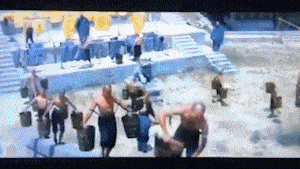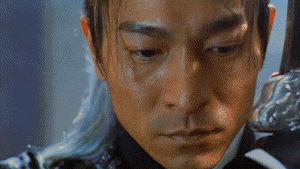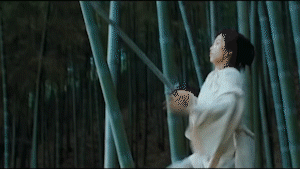On the blog today we are joined by Jeremy Bai who, along with Brendan Davis, designed Righteous Blood, Ruthless Blades: Wuxai Roleplaying. This new addition to the Osprey Roleplaying line will be coming in December, and you can preorder your copy today!
You can find this article, and more details about the game and the genre, on Jeremy's blog.
Righteous Blood, Ruthless Blades is a roleplaying game inspired by wuxia, a Chinese fiction genre. I won’t go into detail about wuxia itself, as there are many online resources that you can use to learn about the genre. In a nutshell, it’s fantasy martial arts fiction. If you’re brand new to wuxia or need a refresher, I suggest diving into the countless wuxia movies and books available online. If you’d like suggestions, you can check out the recommendations page on my website, which contains links to every movie and book we cite or recommend in the Righteous Blood, Ruthless Blades sourcebook.
Considering wuxia is a martial arts genre, it goes without saying that martial arts play a fundamental role in character creation and gameplay. In devising the game’s martial arts system, we drew inspiration primarily from the way kung fu is represented in the movies and novels. And because our aim was “rules-light”, we wanted something simple and easy to grasp.
We decided to group martial arts into three major skills that characters can develop: External, Internal, and Lightness martial arts. These “arts” are so common in wuxia movies and books that the terms are rarely defined in the narrative of the stories. In Chinese, they are 外功 waigong, 内功 neigong, and 轻功 qinggong. There are variations on the terms in Chinese, and there are also multiple ways to translate them into English. That said, the Chinese word for “martial arts” that commonly appears in wuxia is 武功 wugong, which tends to be associated with the fictional side of martial arts (as opposed to 武术 wushu, which is used as the general term for real-life martial arts). The character 武 wu means “martial”, and the second character 功 gong is the same character found in 功夫 (gong fu or Kung Fu). While 功 is sometimes translated as “skill” or something similar, in my opinion, the fact that “martial arts” is the standard translation for 武功 is an excellent argument to translate 功 as “arts” when used with the three skills I mentioned above. The characters 外 wai, 内 nei, and 轻 qing, can be directly translated as external, internal, and light/lightness respectively, so by adding “arts” we have the three branches of martial arts in Righteous Blood, Ruthless Blades. This explains the terms on a language level, but what exactly do they mean, how do they function in the genre, and how do we use them in the game?
External martial arts are related to physical force, and involve tempering one’s body and muscles. In many classic kung fu and wuxia movies, you will see martial artists training by striking their hands into pots of sand or gravel, lifting heavy weights, being struck with hard objects, stretching their limbs painfully to develop flexibility, or doing other grueling physical tasks. These are all examples of the external practice of martial arts. Here's a clip of external arts training from the 1978 classic 36th Chamber of Shaolin.
When it comes to literature, here’s a description of an expert in external arts, from my translation of 7 Killers by Gu Long.
As you can see in this passage, the Iron Monk is so physically powerful that his mere passage leaves footsteps behind him. In Righteous Blood, Ruthless Blades, the External Arts skill is the default for any general martial arts attack, and is intended to reflect physical skill, coordination, strength, and prowess.
What about internal martial arts? They are generally considered the opposite of external arts. They relate to the internal cultivation of energy and typically involve a set of breathing exercises and meditation, not physical training. In other words, they have nothing to do with the “external” body. In wuxia, characters can be physically weak, perhaps even sickly, and yet have an incredibly powerful command of their internal energy, and thus capable of performing extraordinary feats. Here's an example of a sword battle using internal energy, from China's 2000 wuxia summer blockbuster The Duel.
Martial artists can use internal energy for fighting purposes, but other things as well. A perfect example is from Heroes Shed No Tears by Gu Long, another novel I translated.
In wuxia, internal arts are often considered a more advanced and respected form of martial arts. Practitioners will cultivate their internal energy for years to reach incredibly high levels of power, and accomplish tasks that are nothing short of superhuman. It’s the same in Righteous Blood, Ruthless Blades. Many Signature Abilities rely on Internal Arts to replicate the fantastic feats martial artists perform in wuxia, such as Strangling Hair, in which you send long tendrils of your hair out to strangle opponents or throw items, or Grip of the Yang Divinity, in which you send destructive Yang energy into your opponent’s meridians to harm them.
What about lightness arts? Sometimes simply transliterated as qinggong, it refers to techniques used to “lighten” the body and move with greater speed. You can find qinggong training techniques in real-life martial arts, but in wuxia their use is exaggerated to superhuman proportions, allowing the characters to move faster than the eye can track, float, or even 'fly'. Many modern wuxia movies use wirework to portray these abilities, whereas older films often use trampolines or film reversal techniques. Here is a rather elegant depiction of lightness arts from the famous Crouching Tiger, Hidden Dragon (2000).
For a literary example, see the following passage from Dragon King with Seven Stars by Gu Long, another of my translations.
External, Internal, and Lightness Arts form the primary foundation of the game's Signature Abilities, which are specific martial arts styles, talents, etc. That said, there are other skills including Specialist, Unorthodox, Mental, Physical, and Knowledge which can also prove useful both in and out of combat. Hopefully this background information about the three main types of martial arts in the game has proven helpful. As the release of the game gets closer, I hope to delve more into the cultural, language, and genre aspects of wuxia and how they relate to the mechanics of the game.
If you have any questions or comments, please reach out to me via any of the social media links on my website. And if you haven't already, make sure to pre-order the game now!
Considering wuxia is a martial arts genre, it goes without saying that martial arts play a fundamental role in character creation and gameplay. In devising the game’s martial arts system, we drew inspiration primarily from the way kung fu is represented in the movies and novels. And because our aim was “rules-light”, we wanted something simple and easy to grasp.
We decided to group martial arts into three major skills that characters can develop: External, Internal, and Lightness martial arts. These “arts” are so common in wuxia movies and books that the terms are rarely defined in the narrative of the stories. In Chinese, they are 外功 waigong, 内功 neigong, and 轻功 qinggong. There are variations on the terms in Chinese, and there are also multiple ways to translate them into English. That said, the Chinese word for “martial arts” that commonly appears in wuxia is 武功 wugong, which tends to be associated with the fictional side of martial arts (as opposed to 武术 wushu, which is used as the general term for real-life martial arts). The character 武 wu means “martial”, and the second character 功 gong is the same character found in 功夫 (gong fu or Kung Fu). While 功 is sometimes translated as “skill” or something similar, in my opinion, the fact that “martial arts” is the standard translation for 武功 is an excellent argument to translate 功 as “arts” when used with the three skills I mentioned above. The characters 外 wai, 内 nei, and 轻 qing, can be directly translated as external, internal, and light/lightness respectively, so by adding “arts” we have the three branches of martial arts in Righteous Blood, Ruthless Blades. This explains the terms on a language level, but what exactly do they mean, how do they function in the genre, and how do we use them in the game?
External martial arts are related to physical force, and involve tempering one’s body and muscles. In many classic kung fu and wuxia movies, you will see martial artists training by striking their hands into pots of sand or gravel, lifting heavy weights, being struck with hard objects, stretching their limbs painfully to develop flexibility, or doing other grueling physical tasks. These are all examples of the external practice of martial arts. Here's a clip of external arts training from the 1978 classic 36th Chamber of Shaolin.
When it comes to literature, here’s a description of an expert in external arts, from my translation of 7 Killers by Gu Long.
The Iron Monk had ferocious-looking eyebrows and fierce eyes. His face was filled with hatred, and his eyes seethed with murderous intent....
Liu Changjie laughed. “So, you want to kill me?”
“You guessed correctly.”
“Then why haven’t you come over here to try?”
The Iron Monk was already moving forward. His body looked almost like it was sculpted from steel, and his movements resembled that of a gorilla. His footsteps were heavy and stable, and every step he took left footprints behind him in the [stone] floor. The Iron Monk’s external power was clearly exceptional.
As you can see in this passage, the Iron Monk is so physically powerful that his mere passage leaves footsteps behind him. In Righteous Blood, Ruthless Blades, the External Arts skill is the default for any general martial arts attack, and is intended to reflect physical skill, coordination, strength, and prowess.
What about internal martial arts? They are generally considered the opposite of external arts. They relate to the internal cultivation of energy and typically involve a set of breathing exercises and meditation, not physical training. In other words, they have nothing to do with the “external” body. In wuxia, characters can be physically weak, perhaps even sickly, and yet have an incredibly powerful command of their internal energy, and thus capable of performing extraordinary feats. Here's an example of a sword battle using internal energy, from China's 2000 wuxia summer blockbuster The Duel.
Martial artists can use internal energy for fighting purposes, but other things as well. A perfect example is from Heroes Shed No Tears by Gu Long, another novel I translated.
Little Gao took a drink of tea. However, the tea in the cup was cold, so he emptied it onto the ground and poured another. He took a sip, then emptied the second cup too. The tea in the teapot was obviously cold, yet he unexpectedly prepared to pour another cup.
Zhu Meng continued to stare at him, and then asked in a loud voice, “What are you doing?!”
“I’m drinking tea,” Little Gao said. “I’m thirsty, so I want to drink tea.”
“But you’re not actually drinking it.”
“Because the tea is cold. I never drink cold tea.” He sighed. “If I’m drinking alcohol, I don’t care. I can drink any type of alcohol, cold or hot, but I’m very picky about tea. Cold tea is absolutely undrinkable. I’d rather drink poisoned wine.”
“Don’t tell me you think you’re going to get hot tea from that pot?” Zhu Meng asked.
“That’s exactly what I’m thinking.”
“Can’t you tell that the tea in the pot is completely cold?”
“I know. Of course I know.”
Zhu Meng looked at him as if he were some type of freak. “You know that the tea in the pot is cold, but you still think you can pour a cup of hot tea out of it?”
“Not just hot, but scalding hot. The hotter it is, the better the tea tastes.”
Zhu Meng suddenly laughed, then turned and looked at Cleats. “At first, I wanted to chop this kid’s head off, but now I can’t.” He laughed again. “He’s crazy, and I never chop off the heads of crazy people.”
Cleats didn’t laugh, because just now he had caught sight of something very strange.
He saw Little Gao pouring a cup of hot tea from the cold teapot. It was so hot that it bubbled and steamed.
Zhu Meng’s laughter suddenly ceased as he saw the same thing.
Not many people could laugh after seeing something like this. And not many people could control their internal force and heat to warm a pot of cold tea.
In wuxia, internal arts are often considered a more advanced and respected form of martial arts. Practitioners will cultivate their internal energy for years to reach incredibly high levels of power, and accomplish tasks that are nothing short of superhuman. It’s the same in Righteous Blood, Ruthless Blades. Many Signature Abilities rely on Internal Arts to replicate the fantastic feats martial artists perform in wuxia, such as Strangling Hair, in which you send long tendrils of your hair out to strangle opponents or throw items, or Grip of the Yang Divinity, in which you send destructive Yang energy into your opponent’s meridians to harm them.
What about lightness arts? Sometimes simply transliterated as qinggong, it refers to techniques used to “lighten” the body and move with greater speed. You can find qinggong training techniques in real-life martial arts, but in wuxia their use is exaggerated to superhuman proportions, allowing the characters to move faster than the eye can track, float, or even 'fly'. Many modern wuxia movies use wirework to portray these abilities, whereas older films often use trampolines or film reversal techniques. Here is a rather elegant depiction of lightness arts from the famous Crouching Tiger, Hidden Dragon (2000).
Xiao Jun suddenly drew his sword and chopped three chunks of wood out of the trunk of the willow tree. The sword flashed, and the pieces of wood flew out onto the water. The first piece landed nine meters out, the second, fifteen, the third, twenty-one.
By the time the flashing of the blade dissipated, Xiao Jun had already landed on the first piece of wood. The chunk of willow began to sink, and he flew up. His left foot tapped the second piece of wood, his right foot tapped the third. By the time the first piece of wood fully sank and reemerged, he was on the boat.
This was the result of years of bitter training. Xiao Jun believed his lightness arts to be among the top ten in all of the Jianghu.
External, Internal, and Lightness Arts form the primary foundation of the game's Signature Abilities, which are specific martial arts styles, talents, etc. That said, there are other skills including Specialist, Unorthodox, Mental, Physical, and Knowledge which can also prove useful both in and out of combat. Hopefully this background information about the three main types of martial arts in the game has proven helpful. As the release of the game gets closer, I hope to delve more into the cultural, language, and genre aspects of wuxia and how they relate to the mechanics of the game.
If you have any questions or comments, please reach out to me via any of the social media links on my website. And if you haven't already, make sure to pre-order the game now!




Comments
You must be logged in to comment on this post. Click here to log in.
Submit your comment